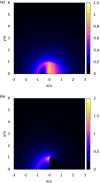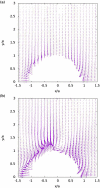Self-thermophoresis of laser-heated spherical Janus particles
- PMID: 34791586
- PMCID: PMC8599244
- DOI: 10.1140/epje/s10189-021-00128-4
Self-thermophoresis of laser-heated spherical Janus particles
Abstract
An analytic framework is presented for calculating the self-induced thermophoretic velocity of a laser-heated Janus metamaterial micro-particle, consisting of two conducting hemispheres of different thermal and electric conductivities. The spherical Janus is embedded in a quiescent fluid of infinite expanse and is exposed to a continuous light irradiation by a defocused laser beam. The analysis is carried under the electrostatic (Rayleigh) approximation (radius small compared to wavelength). The linear scheme for evaluating the temperature field in the three phases is based on employing a Fourier-Legendre approach, which renders rather simple semi-analytic expressions in terms of the relevant physical parameters of the titled symmetry-breaking problem. In addition to an explicit solution for the self-thermophoretic mobility of the heated Janus, we also provide analytic expressions for the slip-induced Joule heating streamlines and vorticity field in the surrounding fluid, for a non-uniform (surface dependent) Soret coefficient. For a 'symmetric' (homogeneous) spherical particle, the surface temperature gradient vanishes and thus there is no self-induced thermophoretic velocity field. The 'inner' temperature field in this case reduces to the well-known solution for a laser-heated spherical conducting colloid. In the case of a constant Soret phoretic mobility, the analysis is compared against numerical simulations, based on a tailored collocation method for some selected values of the physical parameters. Also presented are some typical temperature field contours and heat flux vectors prevailing in the two-phase Janus as well as light-induced velocity and vorticity fields in the ambient solute and a new practical estimate for the self-propelling velocity.
© 2021. The Author(s).
Figures







References
-
- Guix M, Weiz SM, Schmidt OG, Medina-Sanchez M. Self-propelled micro/nanoparticle motors. Part. Part. Sys. Charact. 2018;35:1700382.
-
- Golestanian R, Liverpool TB, Ajdari A. Designing phoretic micro and nano swimmers. J. New Phys. 2007;9:126.
-
- Govrov AO, Richardson HH. Generating heat within metal nanoparticles. Nano Today. 2007;2:30–38.
-
- Baffou G. Thermoplasmonics, Heating Metal Nanoparticles Using Light. Cambridge: Cambridge University Press; 2018.
-
- Li W, Wu H, Qin H, Zhao Z, Liu H. Light-driven and light-guided microswimmers. Adv. Funct. Mater. 2016;26:3164–3171.
Grants and funding
LinkOut - more resources
Full Text Sources

